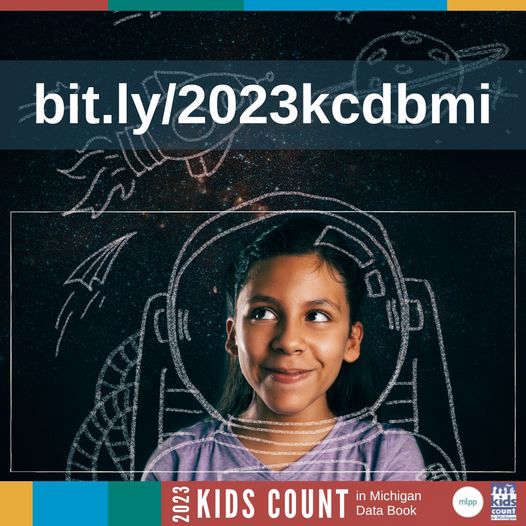
The latest Kids Count data shows fewer kids in Michigan live in poverty, but many expect those numbers to rise as COVID-era policies expire.
-Michigan's child poverty rate is down 15%, according to the Kids Count report, but policy experts fear that decrease may not last much longer as a number of COVID-era policies expire.
The Kids Count report was released Wednesday by the Michigan League for Public Policy, the most recent version of a data book that has been produced since 1992.
Building on the momentum of this year’s historic state budget and people-centered policy strides, today’s release of the 2023 Kids Count in Michigan Data Book provides new evidence and insights related to child well-being that state policymakers can use in evaluating ongoing areas of need for Michigan kids and families.
The Data Book includes statewide and county data and trends in four categories: economic security, education, health and safety, and family and community. Additionally, data is compiled for three cities with some of the highest child populations in the state: Detroit, Flint and Grand Rapids.
This year’s findings include an analysis of trends from, in most cases, 2016 to 2021 (in some cases, 2022 data is used). The statewide data profile shows that Michigan saw improvement in seven of 12 key areas, with much of the latest data coming out during the height of the pandemic when families were receiving significant, but temporary support. Some of the positive statewide trends included declines in rates of child and young adult poverty and teen births. Other key areas, however, worsened, including a decline in third grade reading proficiency as well as increases in low birthweight babies and children that qualify for free or reduced price lunch (families below 185% of the Federal Poverty Level). And while there are broad differences in the key areas for Michigan’s counties, the local data collectively shows there is more to be done to meet the needs of all children and families across the state.
Overall, the positive data and trends in this year’s Data Book point to the importance of one-time investments made at the federal and state level to help Michigan families and children get through the health and economic crises brought on by the COVID-19 pandemic. According to the data, Michigan’s child poverty rate declined by 15% and fell in 76 out of 83 counties from 2016 to 2021. Similarly, Michigan’s young adult poverty rate declined by almost 25% and fell in 75 out of 83 counties over the same time period. These gains, however, may not last without more permanent policy changes.
“The temporary expansion of safety net programs and direct cash assistance provided to kids and their families in 2020 and 2021 certainly played a part in these declines. In what was an extremely tumultuous time, we know that outcomes would have been much worse without the unprecedented levels of investment that we saw,” said Anne Kuhnen, Kids Count in Michigan Policy Director at the Michigan League for Public Policy. “Now, our state leaders need to look at the evidence and take action to make the pandemic-era programs that were successful permanent. We don’t need to wait for another crisis to expand the Child Tax Credit; increase food and rental assistance; or invest in education, child care and healthcare.”
In 2021, roughly 1.8 million Michigan children benefited from the temporary advance Child Tax Credit as part of the American Rescue Plan Act. Recognizing that this was a proven, bipartisan tool in combating child poverty, the League is advocating for Michigan to join a growing number of states that have established a permanent refundable state Child Tax Credit, so even kids in families with very low or no income can benefit. Currently, 1 in 4 kids is left out of the full federal Child Tax Credit because their parents’ earnings are too low.
Among several other policy recommendations included in this year’s Data Book, The League continues to advocate for preservation of federal Temporary Assistance for Needy Families (TANF) dollars for direct cash assistance to families with the lowest incomes and expansion of the state Earned Income Tax Credit (EITC) to workers who are currently excluded, including workers under 25 without children. Fully funding the true cost of child care, closing the gender pay gap and ending punitive fines and fees for justice-involved youth will also help in combating child poverty in the state.
On the education front, the share of students reading proficiently in third grade declined by 8.5% statewide from 2016 to 2022, with declines in 70 out of 83 counties. Fewer than half of all third grade students were reading proficiently before the pandemic, but school disruptions contributed to even worse outcomes. Additionally, 19% of students didn’t graduate on time in 2022–and the percentage was significantly higher for children in foster care at 59%. While the state has made strong investments in K-12 education over the past two years, additional educational support for children in foster care is needed and School Aid Fund dollars need to be preserved for K-12 schools. The diversion of School Aid Fund dollars for higher education institutions since 2010 has harmed Michigan’s public schools, which need adequate funding to prepare students for college and their careers.
On the health and safety front, the statewide teen birth rate fell by 33% from 2016 to 2021–consistent with a longer-term trend in Michigan and nationally. However, the share of low birthweight babies increased by about 6% in that same time period–a slow, but steady increase that is cause for concern. And while continuous enrollment contributed to a 19% increase in Michigan children insured by Medicaid or MiChild in the state from November 2019 to November 2022, this pandemic-era policy is coming to an end. Michigan can learn from the success of this temporary pandemic-era policy by adopting multi-year Medicaid coverage for young children.
“While our state leaders have made some bold strides in making Michigan a better place for all Michiganders–including the historic increase of the EITC to 30% of the federal credit earlier this year–improving the well-being of our youngest residents must continue to be a top priority. Much of the support provided to families during the pandemic should be made permanent and new policy solutions should be explored to help all Michigan families meet their basic needs,” said Monique Stanton, President and CEO of the Michigan League for Public Policy. “This year’s Kids Count policy recommendations provide a clear path to strengthening families and building healthier, brighter futures for the kids growing up in our state today.”

 07/01/20225 - Festivals, Parades, and Fireworks are scheduled this week to celebrate independence.
07/01/20225 - Festivals, Parades, and Fireworks are scheduled this week to celebrate independence.
 06/30/25 - Kent County Man Drowns in Wabassis Lake; Sheriffs Remind Residents of Boating Safety
06/30/25 - Kent County Man Drowns in Wabassis Lake; Sheriffs Remind Residents of Boating Safety
 03/25/25 - Habitat Kent County Plans Major Housing Project
03/25/25 - Habitat Kent County Plans Major Housing Project


